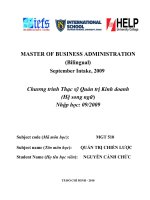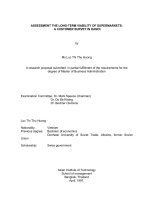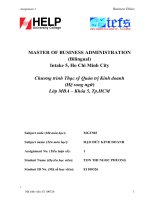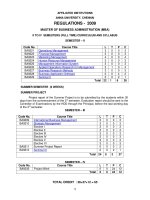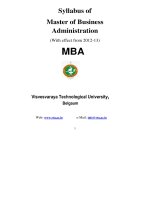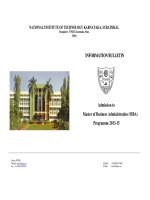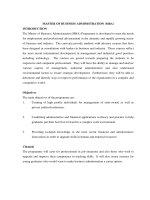Revised Syllabus for Master of Business Administration (M.B.A) potx
Bạn đang xem bản rút gọn của tài liệu. Xem và tải ngay bản đầy đủ của tài liệu tại đây (403.82 KB, 123 trang )
1
University of Pune
Revised Syllabus for Master of Business Administration (M.B.A)
M.B.A. Part I (First Year) Revised from June 2008-09.
M.B.A. Part II (Second Year) Revised from June 2009-10.
(I) Introduction
The name of the course shall be Master of Business Administration (M.B.A.)
(II) Objectives
The basic objectives of an M.B.A. course are-
1. To provide the country a steady stream of competent young men and women with
necessary knowledge, skills, values and attitudes to occupy positions of management
and administration in business, industry, public system and the government.
2. To impart the students latest and relevant knowledge from the field of management
theory and practice.
3. To provide opportunities to the students for developing necessary managerial skills.
4. To impart/ develop the right kind of values and attitude to function effectively in
managerial/ administrative positions.
(III) Eligibility for Admission
Students possessing following qualifications are eligible for admission to MBA course-
(a) A Bachelor’s Degree in any faculty of any statutory University with 45% or more
marks(40% or more marks for students belonging to SC, ST/DT, NT,OBC, SBC for
Maharashtra State Only),
Or
A masters Degree in any faculty of any statutory University with 45% or more
marks(40% or more marks for students belonging to SC, ST/DT, NT,OBC, SBC for
Maharashtra State Only),
(b) Must have completed selection procedure as prescribed by the competent authority
from time to time.
2
Course Structure for Master’s Degree Course in Business Administration
SEMESTER-I
Course
Code
Subject Title Examination Periods Marks
L T
101 Organizational Behavior &
Principles & Practices of
Management
External 60 15 100
102 Management Accounting External 60 15 100
103 Managerial Economics External 60 15 100
104 Statistical & Quantitative
Methods
External 60 15 100
105 Legal Aspects of Business External 60 15 100
106 Basics of Marketing External 60 15 100
107 Information Technology Internal 30 8 50
108 Managerial Communication Internal 30 8 50
SEMESTER-II
Course
Code
Subject Title Examination Periods Marks
L T
201 Marketing Management External 60 15 100
202 Financial Management External 60 15 100
203 Human Resource Management External 60 15 100
204 Manufacturing & Operations
Management
External 60 15 100
205 Materials & Logistics
Management
External 60 15 100
206 Management Information External 60 15 100
3
Systems
207 Research Methodology Internal 30 8 50
208 Economic Environment of
Business & Environmental
Management
Internal 30 8 50
SEMESTER-III
Course
Code
Subject Title Examination Periods Marks
L T
301 Business Policy & Strategic
Management
External 60 15 100
302 Management Control Systems External 60 15 100
303 Specialization I External 60 15 100
304 Specialization II External 60 15 100
305 Specialization III External 60 15 100
306 Specialization IV Internal 30 8 50
307 Specialization V Internal 30 8 50
308 Project Report External 100
SEMESTER-IV
Course
Code
Subject Title Examination Periods Marks
L T
401 Entrepreneurship Development
& project Management
External 60 15 100
402 International Business
Management
External 60 15 100
403 Current Trends in Management
External 60 15 100
4
404 Specialization VI External 60 15 100
405 Specialization VII Internal 30 08 50
406 Specialization VIII Internal 30 08 50
407 Specialization IX External 60 15 100
408 Specialization X External 60 15 100
Notes:-
1. “L” Indicates Lecture Periods of 45 Minutes each and “T” Indicates Tutorial Periods of 45
Minutes each.
2. In case of subjects for University evaluation, 30% marks are reserved for internal
evaluation and 70% marks are reserved for University evaluation. Passing percentage will be
40% for internal and external evaluation separately.
3. After every three years, syllabus will be revised.
(IV) Number of Lecturers-
For external subjects, there shall be at least 60 lectures and 15 lectures for Tutorials/
Seminars/Assignments per semester per course.
For internal subjects, the there shall be at least 30 lectures and 8 lectures for Tutorials/
Seminars/Assignments per semester per course.
(V) Practical Training and Project Work-
Each student shall have to undergo a practical training for a period of not less than 50 days
during the vacation at the end of First Year.
Based on the actual training during the vacation, the student shall write a project report on
the topic selected under the guidance of a faculty and submit two copies of the same to the
Director of the institute before 30
th
September. The project Report shall be assessed both
internally (30 marks) and externally (70 marks) .For external evaluation there will be a viva
voce at the end of third semester. Such viva-voce shall be conducted by a panel of two
referees appointed by the University.
(VI) Marks
5
The papers marked as “External” in the course structure will be evaluated by the University
and carry 100 marks. Out of these 100 marks 70 marks are reserved for University
Evaluation based upon comprehensive written examination and 30 marks are reserved for
internal evaluation by the individual Institutes. The papers marked as “Internal” in the Course
Structure will be evaluated internally by the individual Institute and such marks will be
communicated to the University at the end of each semester. These marks will be considered
for the declaration of the results.
(VII) Specialization:-
In second year, a student shall select a special subject, consisting of 10 Unit Courses, from
following Functional areas :-
Group A- Marketing Management
Group B- Financial Management
Group C- Computer Management
Group D- Production and Materials Management
Group E-Human Resource Management
Group F- International Business
For each of the above fields of specialization the syllabus includes eight courses for semester
III and semester IV separately. An individual institute has to select any five of the suggested
titles to be offered to their students. Out of the five titles selected, three should relate to full
papers (i.e. carrying 100 marks) and two should relate to internal papers( i.e. carrying 50
marks)
(VIII) Rules for specialization
Student for the special course under 303A, 304A, 305A, 306A, and 307A, shall offer 404A,
405A, 406A, 407A and 408A only.
Student for the special course under 303B, 304B, 305B, 306B, and 307B, shall offer 404B,
405B, 406B, 407B and 408B only.
Student for the special course under 303C, 304C, 305C, 306C, and 307C, shall offer 404C,
405C, 406C, 407C and 408C only.
6
Student for the special course under 303D, 304D, 305D, 306D, and 307D, shall offer 404D,
405D, 406D, 407D and 408D only.
Student for the special course under 303E, 304E, 305E, 306E, and 307E, shall offer 404E,
405E, 406E, 407E and 408E only.
Student for the special course under 303F, 304F, 305F, 306F, and 307F, shall offer 404F,
405F, 406F, 407F and 408F only.
(IX) Assessment
The final total assessment of the student shall be made in terms of an internal assessment and
an external assessment.
(a) The internal and external assessment will constitute separate heads of passing and
they will be shown separately in the marks sheet.
(b) For each paper meant for University evaluation, the ratio of marks for internal
assessment in relation to external assessment shall be 30:70
(c) The external assessment shall be based upon the external written examination to be
held at the end of each semester.
(d) The project Report and viva shall constitute one head of passing.
(e) The marks awarded by a teacher in the internal evaluation for the papers marked as
“External” in the courses structure shall be immediately communicated to the student.
The Institute should communicate internal marks to the students
(f) Reassessment of Internal Marks –in case of those students who have secured less than
passing percentage of marks in the internal evaluation for the paper marked as “
External” in the course structure, the concerned Institute should administer a separate
internal test for these 30 marks in the subsequent semester. The results of such test
7
may be communicated to the University as the Revised Internal marks. If the result of
internal test as above results in lower marks should be prevailed. In short, the rule is
higher of the two figures of the marks shall be taken into consideration.
(X) Examinations
The M.B.A. examination will be held in four semesters. The student will not be allowed
to appear for the examination unless his attendance is minimum 75%. The student will be
allowed to carry maximum backlog of eight (8) heads of passing from any one or more
semesters.
(XI) Standard of passing
Every student must secure 40% marks in both University Evaluation as well as Internal
Evaluation.
(XII) Grading
There shall be numerical marketing for each course. At the time of declaration of the
result, the marks obtained by a student shall be converted into the grades as shown below.
Grade Percentage
A+ 70 & above
A 60-70 Less than 70
B+ 55-60 Less than 60
B 50-55 Less than 55
C 40-50 Less than 50
F Below 40
(Grade F stands for failure)
(Fraction to be rounded up to next higher integer)
(XIII) Transcript for Students
Every student shall be given a transcript, showing the name of the Institution, the courses
offered by the student, the date of enrollment in the course, the dates of the examination,
the dates of the external examination, and details of marks of internal and external
assessment. The transcript will further indicate the rank, if the student secures the rank
amongst the first 10 ranks in the entire examination.
(XIV) Additional Specialization:-
8
A student who has passed the M.B.A. Examination of this University may be allowed to
appear for the M.B.A. examination again, in any other special group only, by keeping
terms for the third and fourth semester for that special group i.e. for papers comprising of
800 marks out of a total of 1400 marks, at proportionate fees (57%) of the Tuitions Fees
(XV) Teaching Faculty
Besides full time faculty members, part-time, adjunct and visiting faculty members
should be invited to conduct the professional courses. Visiting faculty should normally
satisfy one of the following criteria:
(a) Master’s degree of a recognized University in a relevant subject or professional
qualifications like ACA, AICWA, or ACS.
(b) Master’s degree of recognized University in any faculty with at least two years
professional experience related to the given subject.
(c) Bachelor’s degree of recognized University in any faculty with at least 5 years
professional experience related to the given subject.
(d) Diploma of a recognized University/ Board with at least 7 years professional
experience related to the given subject.
University Of Pune
Syllabus for Master in Business Administration (M.B.A.)
Semester I
(101) ORGANIZATIONAL BEHAVIOUR & PRINCIPLES & PRACTICE OF
MANAGEMENT
SECTION I:-
Organizational Behaviour
1. Introduction to Organizational Behaviour: Definition, Importance, Scope,
Fundamental Concepts of OB, Different models of OB - autocratic, custodial,
supportive, collegial and SOBC. (4)
9
2. Personality & Attitudes: Meaning of personality, attitude - Development of
personality – Attributes of personality- Transactional Analysis – Ego states –
Johari window - Nature and dimensions of attitude – Developing the right attitude
(4)
3. Motivation: Definition, Importance, Motives – Characteristics, Classification of
motives - Primary & Secondary motives. Theories of Motivation - Maslow’s
Theory of need hierarchy - Herzberg's theory. Morale - Definition and relationship
with productivity - Morale Indicators. (4)
4. Group Dynamics and Team building: Concept of Group & Team. Theories of
Group Formation - Formal and Informal Groups. Importance of Team building.
(4)
5. Conflict Management: Definition. Traditional vis-à-vis Modern view of conflict
– Types of conflict – Intrapersonal, Interpersonal, Organizational. Constructive
and Destructive conflict. Conflict management. (3)
6. Stress management: Definition, Causes, Managing stress, Stress as a motivator.
Work life balance. (2)
7. Change management: Concept of change, change as a natural process,
Importance & Causes of change – social, economic, technological,
organizational. Learning – unlearning, Concept of learning organizations. (4)
8. Cases studies on above topics
(5)
SECTION II:
Principles and Practice of Management
1. Basic concepts of management: Definition – Need and Scope – Different schools of
management thought – Behavioural, Scientific, Systems, and
Contingency
(4)
2. Contribution of Management Thinkers: Taylor, Fayol, Elton Mayo (4)
3. Functions of Management –
a) Planning – Concept, Nature, Importance, Steps, Limitations, Management by
objectives (2)
b) Organizing - Concept, Nature, Importance, Principles, Centralization,
Decentralization, Organization Structures- Line and Staff Authority, Functional,
Product, Matrix, Geographical, Customer, New Forms of Organization – Virtual,
Organizations as Networks - Types of Network Organizations/Clusters - Self-
Organizing Systems. Organizational Designs for Change and Innovation -
Designing Principles for New Forms of Organizations (3)
c) Staffing - Concept, Nature, Importance, Steps. Concept of knowledge worker. (2)
d) Directing – Concept, Nature, Importance. (1)
e) Controlling - Concept, Nature, Importance, Process of controlling, Control
Techniques. (2)
4. Leadership: Concept, Nature, Importance, Attributes of a leader, developing
10
leaders across the organization, Leadership Grid. (4)
5. Decision making: Concept, Nature, Importance, and Process. Types of decisions.
Problems in decision making. (4)
6. Case Study: Planning, Decision Making, Leadership. (4)
Books Recommended:-
1. Organizational Behaviour, 9th Ed. - Stephen Robbins
2. Human Behaviour at work - Davis and Newstorm
3. Organizational Behaviour - Uma Sekaran
4. Organizational Behaviour - Fred Luthans
5. Organizational Behaviour - K.Aswathappa
6. Human Behaviour at Work - Keith Davis
7. Organizational Behaviour - Jit S.Chandran
8. Human Relations & Organizational Behaviour - R.S.Dwivedi
9. Organizational Behaviour - McShane
10. Organizational Behaviour - Sharma
11. Essentials of Management – Koontz – TMGH -
12. Principles & Practices of Management - Saxena
13. Principles and Practices of Management - Shejwalkar and Ghanekar
14. Management Concepts & Practices - Hannagan
102-MANAGEMENT ACCOUNTING
1. Meaning and Definition of Accounting, Parties or Users interested in Accounting,
Branches of Accounting, Meaning and Definition of Management Accounting,
Distinction between Management Accounting and Financial Accounting. Accounting
Concepts and Conventions. (10)
2. Basic Accounting terminologies, Classification of Accounts, Meaning of Journal,
Writing of Journal Entries. (5)
3. Secondary Books of Accounting, Preparation of Trial Balance, Final Accounts of
Sole Traders. (14)
4. Elements of Costs; (10)
11
(a) Materials Costs: - Materials purchasing, receiving, storing and issuing
including pricing of issues.
(b) Labour Costs and Labour Turnover.
(c) Overheads- Identifying the overheads with cost centre. Allocation,
Apportionment and Absorption – Accounting treatment of Under and Over
Absorption.
(d) Preparation of Cost Sheet, items to be excluded while preparing cost sheet.
5. Managerial Decision Making Techniques like (21)
(a) Marginal costing – Cost volume profit analysis, BEP
(b) Budgetary control, Operating and Financial Budgets, Flexible Budgets.
(c) Standard Costing – Materials Cost and Labour cost variances only.
Books Recommended:-
1. Introduction to Management Accounting - Horngreen and Sundlem
2. Principles of Management Accounting - Manmohan & Goyal
3. Management Accounting - Dr. E.B. Khedkar, Dr. D.B. Bharati and Dr. A. B. Kharpas.
4. Cost and Management Accounting - S.M.Inamdar
5. Management Accounting - Dr. Mahesh Kulkarni
6. Double Entry Book Keeping - T.S.Grewal
7. Principles and Practice of Cost Accounting – Ashish K. Bhattacharya
8. Management Accounting 3rd Ed. - Khan & Jain
9. Theory & Problems in Management & Cost Accounting - Khan & Jain
10. Cost Accounting – Jawaharlal
11. Management Accounting - Dr. A. P. Rao
103-MANAGERIAL ECONOMICS
1. Definition, Nature and Scope of Managerial Economics, Managerial
Economics and Microeconomic and Macroeconomics. Managerial Economics
and decision-making. Definitions of basic concepts:
a. Positive and normative approach
b. Optimization
c. Marginal analysis
d. Opportunity Cost.
e. Economic Model.
f. Static and Dynamics. (8)
2. Meaning and Determinants of demand. Demand Function. Law of Demand,
Market Demand, Elasticity of demand. Types of elasticity. Measurement of
12
elasticity. Significance and uses of the elasticity. Methods of Demand
estimation. Demand forecasting. Forecasting of an established product.
Forecasting of a new product. (8)
3. Production Function. Law of Variable Proportions. Law of supply. Elasticity
of supply. Measurement of elasticity. Significance and uses of the concept of
elasticity. (6)
4. Costs of production. Private costs and Social Costs. Accounting Costs and
Economic costs. Short run and Long Run costs. Economies of scale. Cost
estimation. Methods of cost estimation and cost forecasting. Cost reduction
and cost control. (6)
5. Pricing under various markets including: Perfect Competition, Monopoly,
Monopolistic competition, oligopoly. Cartels. Price discrimination.
Measurement of Monopoly Power. (8)
6. Pricing Strategies and Methods – Cost plus pricing. Marginal cost pricing.
Cyclical pricing. Penetration Pricing. Price Leadership. Price Skimming.
Transfer pricing. (8)
7. Profit Policy: Break Even analysis. Profit Forecasting. (4)
8. Capital Budgeting – steps involved in project evaluation. Concept of time
value of money. Methods of investment Appraisal: Discounted Cash flow. Net
Present Value. Internal Rate of Returns. (8)
9. Need for Government Intervention in Markets. Price Controls. Support Price.
Preventions and Control of Monopolies. System of Dual Price.
(4)
Books Recommended:-
1. Managerial Economics – Analysis, Problems and Cases, P.L. Mehta,
Sultan Chand Sons, New Delhi.
2. Managerial Economics – Varshney and Maheshwari, Sultan Chand and
Sons, New Delhi.
3. Managerial Economics – D. Salvatore, McGraw Hill, New Delhi.
4. Managerial Economics – Pearson and Lewis, Prentice Hall, New Delhi
5. Managerial Economics – G.S. Gupta, T M H, New Delhi.
6. Managerial Economics – Mote, Paul and Gupta, T M H, New Delhi.
7. Managerial Economics –Joel Dean, Prentice Hall, USA.
8. Managerial Economics –H L Ahuja, S Chand & Co. New Delhi.
13
(104) STATISTICAL & QUANTITATIVE METHODS
1. Arranging data to convey meaning - Tables, Graphs and Frequency Distribution
(6)
2. Measures of Central Tendency – Arithmetic Mean, Median, Mode. Measures
of Dispersion – Range, Quartile, Mean Deviation, Standard Deviation, Coefficient
of Variation.
(6)
3. Correlation – Karl Pearson coefficient & Rank correlation – Partial & Multiple
correlation. Simple and Multiple Regression (Linear) – Equation and prediction
(6)
4. Association of Attributes: Yule’s coefficient & Coefficient of colligation.
(6)
5. Probability – Concept, Bayes’ theorem. Probability Distributions - Binomial,
14
Poisson and Normal
(6)
6. Linear Programming – Formulation. Graphical solution, Transportation &
Assignment Problems – all methods
(6)
7. Queuing Theory - Single Server ( M/M/I , Infinite, FIFO) and Multi Server
(M/M/C , Infinite, FIFO)
(6)
8. Markov Chains & simulation techniques. Monte Carlo Simulation
(6)
9. Games Theory - 2x2 zero sum game with dominance - Pure Strategy and Mixed
Strategy
(6)
10. Decision Theory - Decision making under risk (EMV criteria) and Decision
making under uncertainty
(6)
Books Recommended:-
1. Statistical and Quantitative Methods – By Ranjit Chitale
2. Statistical Methods - S.P.Gupta
3. Statistics for Management - Levin and Rubin
4. Quantitative Techniques Vol. 1 and 2 - L.C.Jhamb
5. Statistics and Quantitative Techniques - M.G.Dhaygude
6. Quantitative Techniques - N.D.Vohra
(105) LEGAL ASPECTS OF BUSINESS
I. The Contract Act, 1871
1.1 Nature and classification of contracts - Essential elements of a valid contract
1.2 Offer and Acceptance - Consideration - Capacities of Parties
1.3 Provisions relating to free consent, void agreements
1.4 Provisions relating to performance and discharge of contract
1.5 Breach of contract - Meaning and remedies (8)
II. Contract Act, 1872
2.1 Contracts of Indemnity - Meaning, nature - Right of Indemnity Holder and
Indemnifier
2.2 Contracts of Guarantee - Meaning, Nature and Features - Types of Guarantee
- Provisions relating to various types of Guarantee
15
2.3 Surety and Co-surety - Rights and Liabilities - Discharge of surety from his
liability
2.4 Agency - Agent and Principal - Creation of Agency - Classification of Agents
- Relationship between Principal and Agent - Agent's authority - Revocation and
Renunciation - Rights, Duties and Liabilities of Agent and Principal - Termination
of Agency (7)
III. Sales of Goods Act, 1930
3.1 Contract for Sale of Goods - Meaning - Essentials of a Contract of Sale -
Formalities of a Contract of ale
3.2 Provisions relating to conditions and Warranties
3.3 Provisions relating to transfer of property or ownership
3.4 Provisions relating to performance of Contract of Sale - Rights of Unpaid
Seller – Rules as to delivery of goods. (6)
IV. The Negotiable Instruments Act, 1881
4.1 Negotiable Instruments - Meaning, Characteristics, Types, Parties - Holder
and holder in Due Course
4.2 Negotiation and Types of Endorsements
4.3 Dishonour of Negotiable Instrument - Noting and Protest
4.4 Liability of parties on Negotiable Instrument.
(10)
V. The Companies Act, 1956
5.1 Company - Definition, Meaning, Features and Types of companies
5.2 Incorporation of a company - Memorandum of Association, Articles of
Association and Prospectus
5.3 Share Capital (10)
VI. The Consumer Protection Act, 1986
6.1 Definitions of Consumer, Complainant, Goods, Service - Meaning of
Consumer Dispute, Complaint - Unfair Trade Practices - Restrictive Trade
Practices
6.2 Rights of Consumers
6.3 Consumer Disputes Redressal Agencies (6)
VII. The Information Technology Act, 2000
7.1 Digital Signature - Digital Signature Certificate
7.2 Electronic Governance
7.3 Electronic Records
7.4 Certifying Authorities
7.5 Penalty & Adjudication (10)
VIII Patents Act
8.1 Conceptual understanding of patents, copyrights, trademarks and designs. (3)
Books Recommended:-
16
1. Business Laws - Balchandani
2. Business Laws - S.D.Geet and M.S.Patil
3. Business Laws - Gulshan Kapoor
4. Business and Commercial Laws - Sen and Mitra
5. An Introduction to Mercantile Laws - N.D.Kapoor
6. Business Laws - N.M.Wechlekar
7. Business Laws - M.D.Mulla
8. Company Law - Avtar Singh
9. Bare Text of the relevant Act
(106) BASICS OF MARKETING
1. Introduction to Marketing: Definition & Functions of Marketing.
Core concepts of marketing –
a) Need, Want, Desire, Benefits, Demand, Value, Exchange,
b) Goods – Services Continuum, Product, Market
c) Customer Satisfaction, Customer Delight.
d) Approaches to Marketing – Product – Production - Sales – Marketing –
Societal – Relational. Concept of Marketing Myopia. Selling versus
marketing.
e) Holistic Marketing Orientation & Customer Value (12)
2. Consumer Behaviour: Concept, Characteristics of consumer and organizational
markets, 5 step Buyer decision process. (6)
17
3. Marketing Environment: Analyzing needs and trends Macro Environment -
Political , Economic, Socio-cultural and Technical Environment – PEST
analysis. Micro Environment – Industry & Competition. Concept of Market
Potential & Market Share (6)
4. Market segmentation: Definition, Need & Benefits. Bases for market
segmentation of consumer goods, industrial goods and services. Segment, Niche
& Local Marketing, Effective segmentation criteria, Evaluating & Selecting
Target Markets, Concept of Target Market and Concept of positioning – Value
Proposition & USP. (10)
5. Marketing Mix: Definition of each of the Four P's. Components of each P.
Extended 7Ps for services. Significance in the competitive environment. (8)
6. Marketing Planning: Contents of Marketing Plan - Developing Marketing
Plan for variety of goods and services. (8)
7. Marketing organization: Concept, Types - Functional organization, Product
Focused organization, Geographic Organization, Customer Based
Organization, Matrix organization. Organization structure for a wide
customer orientation. (4)
8. Market Evaluation and Controls: Generic Process, Need and Significance of
marketing control. Marketing Audit. (4)
9. Social responsibility of marketing organizations.
(2)
Books Recommended:-
1. Principles of Marketing 12th Edition - Philip Kotler and Gary Armstrong
2. Fundamentals of Marketing - Stanton
3. Marketing Management – Rajan Saxena
4. Marketing Management - V.S.Ramaswamy and S.Namakumari
5. Analysis for Marketing Planning – Donald Lehmann & Rusell Winer, 6th ed.
6. Case Studies in Marketing - Indian context - R.Srinivas
18
(107) INFORMATION TECHNOLOGY
1. Introduction to Computers: Hardware - Software - Systems Software, Application
Software and Packages - Introduction to Embedded Software. Fundamentals of
operating system- Windows, Unix/Linux. Introduction to World Wide Web -
Internet operations. Emerging communication technologies *****
(4)
2. Software Packages
2.1 Microsoft Word – Mail merge (2)
2.2 Microsoft Excel – Formulas, Graphs, Basis statistical formulae. (4)
2.3 Microsoft Power Point – Creating effective presentations (4)
2.4 Microsoft Access - Introduction to DBMS concepts, Creating a database,
Basic queries. (6)
2.5 Tally – Journal Entry, Ledger posting, Preparation of Balance Sheet (6)
19
3. HTML – Home page designing for each student using Microsoft FrontPage. (4)
Note: Chapters 2 and 3 must be conducted as practical with hands on exposure.
Books Recommended:-
1. Rajaraman, V. (2004). Introduction to Information Technology. PHI.
2. Turban, Rainer and Potter (2003). Introduction to information technology. John
Wiley and sons.
3. Sinha, P.K., Priti Sinha (2002). Foundation of computing. BPB Publications.
4. Ram, B. (2003). Computer Fundamentals. New Age Publications
(108) MANAGERIAL COMMUNICATION
1. Introduction to managerial communication: Meaning, Importance & objectives
- Principles of Communication, forms of communication, Communication
Process, Barriers of effective communication, Techniques of effective
communication. (2)
2. Nonverbal communication: Body Language, Gestures, Postures, Facial
Expressions, Dress codes. The Cross Cultural Dimensions of Business
Communication. Listening & Speaking, techniques of electing response, probing
questions, Observation. Business and social etiquettes. (6)
3. Managerial speeches: Principles of Effective Speech & Presentations. Technical
20
& Non-technical presentations. Speech of introduction - speech of thanks -
occasional speech - theme speech. Use of audio visual aids. (6)
4. Interview Techniques: Mastering the art of conducting and giving interviews,
Placement interviews - discipline interviews - appraisal interviews - exit
interviews. (2)
5. Group communication: Importance, Meetings - group discussions.
Videoconferencing. (2)
6. Introduction to managerial writing: Business letters: Inquiries, Circulars,
Quotations, Orders, Acknowledgments Executions, Complaints, Claims &
adjustments, Collection letter, Banking correspondence, Agency
correspondence, Bad news and persuading letters, Sales letters, Job application
letters - Bio-data, Covering Letter, Interview Letters, Letter of Reference.
Memos, minutes, Circulars & notices. (8)
7. Reports: Types of Business Reports - Format, Choice of vocabulary, coherence
and cohesion, paragraph writing, organization reports by individual, Report by
committee. (4)
Books Recommended:-
1. Lesikar, R.V. & Flatley, M.E. (2005). Basic Business Communication Skills for
Empowering the Internet Generation. Tata McGraw Hill Publishing Company Ltd.
New Delhi.
2. Ludlow, R. & Panton, F. (1998). The Essence of Effective Communications. Prentice
Hall of India Pvt. Ltd.
3. Adair, J. (2003). Effective Communication. Pan Mcmillan.
4. Thill, J. V. & Bovee, G. L. (1993). Excellence in Business Communication. McGraw
Hill, New York.
5. Bowman, J.P. & Branchaw, P.P. (1987). Business Communications: From Process to
Product. Dryden Press, Chicago.
.
MBA Semester II
(201) MARKETING MANAGEMENT
1. PRODUCT: Product – Meaning, Goods & Services, Product Mix, Levels of Product,
Product Life Cycle - Managing the product in Product Life Cycle. (8)
2. NEW PRODUCT DEVELOPMENT- Types of new products - Test Marketing a new
product – Portfolio analysis, Branding - Definition, Purpose and Significance, Branding
decisions - Packaging & Labeling - Purpose, Types and new trends in packaging. (10)
3. PRICE: Meaning, Importance, Pricing objectives, Factors influencing pricing
decision - Approaches to pricing – Price & Non-price competition, Setting the price
21
and managing the price changes. (8)
4. PLACE: Importance, functions of distribution channels - Introduction to the various
channels of distribution – Designing marketing channels – Introduction to Wholesaling,
Retailing, Franchising, Direct Marketing, Impact of technology & Internet on
distribution. (8)
5. PROMOTION: Concept and role in marketing, Promotional Mix - Advertising, Sales
Promotion, Personal Selling, Public Relations. Impact of technology & Internet on
Promotion (8)
6. Extended P’s of Marketing – People, Process & Physical Evidence (8)
7. Caselets Discussions (10)
Books Recommended:-
1. Marketing Management - Philip Kotler
2. Fundamentals of Marketing - Stanton
3. Marketing Management - V.S.Ramaswamy and S.Namakumari
4. Principles of Marketing 12th Edition - Philip Kotler and Gary Armstrong
5. Marketing Models - Lilien & Kotler & Moorthy
6. Case Studies in Marketing - Indian context - R.Srinivas
7. Case study solutions - H.Kaushal
8. Marketing Management – Rajan Saxena
9. Marketing - Gandhi
(202)-FINANCIAL MANAGEMENT
1. Concept of Finance, Corporate Finance, Finance Functions and other functions.
Structures of the Financial System. (6)
2. Financial Management – Meaning and Objectives, A’s of Financial Management,
Scope and Functions of Financial Management, Financial Planning and Forecasting.
(6)
3. Capitalization – Under and Over Capitalization, Capital Structures – Computation of
cost of capital, Trading on Equity, Leverages – Type and Significance (6)
4. Capital Budgeting – Nature and Significance, Time value of money- Discounting and
Compounding – Methods of evaluating Capital Expenditure proposals (9)
22
5. Financial statements of Corporate organizations, Introduction to Schedule- VI,
Provisions of Companies Act 1956. (9)
6. Analysis and interpretation of Financial Statements using the techniques of Ratio
Analysis and Fund Flow analysis. (9)
7. Working Capital Management – Nature of Working Capital Management, Need for
working capital – operating cycle, estimation of working capital requirement –
Management of Cash and Receivables, Cash Budget. (9)
8. Management of Profits-Dividend Policy, Procedural and Legal formalities involved in
the payment of dividend-Bonus Shares. (6)
Books Recommended:-
1. Financial Management – I.M.Pandey
2. Financial Management – Khan & Jain
3. Financial Management – S.M.Inamdar
4. Financial Management – N.M.Wechlekar
5. Financial Management – S.C.Kuchal
6. Financial Management & Policy – R.M.Shrivastava
7. Financial Management – Prasanna Chandra
8. Financial Management- P.V. Kulkarni
(203)-HUMAN RESOURCES MANAGEMENT
1. Human resources Management-Introduction and Importance-Evolution –
difference between Personnel Management and HRM- Strategic HRM- role of a
HR Manager. (6)
2. Human Resources Planning-Objectives-Importance-HRP Process- Manpower
Estimation-Job analysis-Job Description-Job Specification. Recruitment-Sources
of Recruitment-Selection Process-Placement and Induction-Retention of
Employees. (8)
3. Training and Development- Objectives and Needs-Training Process-Methods of
Training –Tools and Aids-Evaluation of Training Programs. (8)
4. Career Planning- Succession Planning. (2)
23
5. Performance Management System-Definition, Concepts and Ethics-Different
methods of Performance Appraisal- Rating Errors-Competency management. (8)
6. Compensation Management –Concepts and Components-Job Evaluation-
Incentives and Benefits. (8)
7. Productivity Management-Concepts-TQM-Kaizen-Quality Circles (6)
8. Industrial relations-Grievance Procedure-collective Bargaining-Settlement of
Disputes. (6)
9. Retirement/Separation-Superannuation-Voluntary Retirement Schemes-
Resignation-Discharge-Dismissal-Suspension-Layoff. (8)
Books Recommended:-
1. Human Resources Management- Gary Dessler
2. Personnel Management – C.B Mamoria
3. Managing Human Resources - R.S. Dwiwedi
4. Human Resources Management-V.P.Michael
5. Human Resources Management – Dr.P.C.Pardeshi
6. Human Resources Management – Mirza & Zaiyadin
7. Human Resources Management – L.M.Prasad
8. Human Resources Management - Ashwathappa
9. Managing Human Resources - Arun Monppa
(204) MANUFACTURING AND OPERATIONS MANAGEMENTS
1. Introduction to Operations Management - Nature, Scope, Importance and Functions
- Evolution from manufacturing to operations management - Evolution of the factory
system - manufacturing systems –quality – mass customization. Contribution of Henry
Ford, Deming, Crossby, Taguchi, (6)
2. Types of Industries – Variety of Businesses – Integration of Manufacturing & Services –
Scale of Operations. Methods of Manufacturing - Project / Jobbing, Batch Production,
Flow/Continuous Production, Process Production -Characteristics of each method
(8)
3. Facilities Location & Layout – Strategic importance - Factors affecting location &
layout - Installation of facilities – Single location, multi-location decisions. Principles and
Types of Facilities Layout. (8)
24
4. Importance and Functions of Production Planning & Control. Introduction to
PERT / CPM - Network Crashing (Numericals expected for PERT/CPM) (8)
5. Maintenance Management - Importance and types of maintenance - Maintenance
Planning - Spare Parts Management – Concept of TPM. (6)
6. Inspection - Cent percent Inspection, Sample Inspection, Operation Characteristics
Curves, Statistical Quality Control – Construction & Interpretation of Control Charts –
(X-R, n, p, c, np) Introduction to Six Sigma, (Numericals expected for Control Charts).
Gap analysis for service quality assessment. (10)
7. Productivity - Work Study - Objectives, Scope and Uses - Methods Study – Flow
process chart, Flow diagram & Process mapping - Work Measurement - Elements -
Performance Rating - Allowances - Standard Time - Synthetic Time Standards - Work
Sampling (Numericals expected for Standard Time) (10)
8. Lean Production Systems – TOYOTA system – JIT - KANBAN - Theory of
Constraints (4)
Books Recommended:-
1. Operations Management - Krajewski
2. Operations Management - Mahadevan
3. Production & Operations Management - Chary
4. Production & Operations Management - Chase
5. Production & Operations Management - Adam & Ebert
6. Manufacturing & Operations Management - L.C.Jhamb
7. The Machine that Changed the World – James Womack (Reference)
8. The Goal – Eliyahoo Goldaratt (Reference)
(205) MATERIALS & LOGISTICS MANAGEMENT
1. Introduction: Materials Management - Evolution, Importance, Scope and Objectives
- Interface with other functions. Concept of Logistics and Supply Chain Management and
evolution to 4PL (6)
2. Logistics - Objectives, Components, Significance. Supply Chain Management –
Objectives, Components, Significance, Trade off Customer Service & Cost. (6)
3. Inventory - Need of Inventory - Costs associated with Inventory - Types of Inventory
- Basic EOQ Model - EOQ with discounts - Classification of material - ABC Analysis -
VED, HML, FSN, GOLF, SOS (Numericals expected on Basic EOQ, EOQ with
discounts & ABC) (10)
25
4. Material Requirement Planning - Advantages over conventional planning (Order
Point Method) – Input and output of MRP system - Forecasting – Overview of
quantitative and qualitative methods of forecasting - Master Production Schedule - Bill of
Materials – BOM Explosion - Material flow in MRP. MRP II. Concept of ERP.
(Numericals expected on BOM Explosion, estimating Net requirements)
(12)
5. Purchasing Management - Responsibilities of Purchase Department - Purchase Cycle
– Negotiation & Bargaining – Vendor relations - Purchasing Methods - Global sourcing
(8)
6. Stores – Functions, Importance, Organization of stores & Stores layout. Stores
procedure – documentation. (5)
7. Inventory control & Cost Reduction techniques: Inventory turns ratios -
Standardization – need and importance. Codification – concept, benefits. Value
Engineering and Value Analysis – concept and process. (8)
8. Materials Handling - Principles of Materials Handling system - Materials Handling
Equipments – Safety issues. (5)
Books Recommended:-
1. Purchasing and Supply Management - Dobler and Burt
2. Materials Management - Dutta
3. Purchasing and Materials Management - K S Menon
4. Handbook of Materials Management - Gopalkrishnan
5. Materials & Logistics Management - L.C.Jhamb
6. Introduction to Materials Management – Arnold
7. Logistics & Supply Chain Management – Martin Christopher
(206) MANAGEMENT INFORMATION SYSTEMS
1. Management Information Systems - Need, Purpose and Objectives -
Contemporary Approaches to MIS - Information as a strategic resource - Use of
information for competitive advantage - MIS as an instrument for the
organizational change (8)
2. Information, Management and Decision Making - Models of Decision Making -
Classical, Administrative and Herbert Simon's Models - Attributes of information and its
relevance to Decision Making - Types of information (8)
3. Information Technology - Definition, IT Capabilities and their organizational
impact -Telecommunication and Networks - Types and Topologies of Networks -
IT enabled services such as Call Centers, Geographical Information Systems etc. (6)
